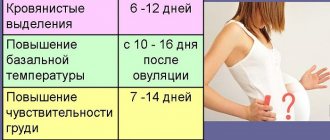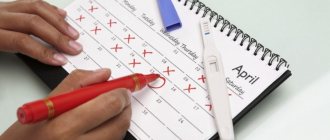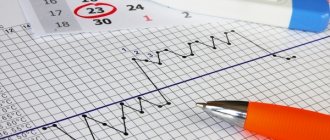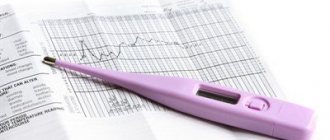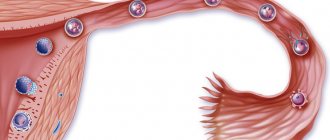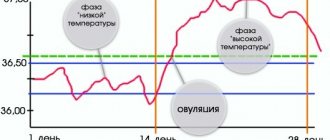Wanting to get pregnant, women try to find out as much information as possible about conception. Fertilization is possible only during the shortest stage of the menstrual cycle - the ovulation phase. Depending on the number of days in a girl's cycle, the appropriate time for sperm to fertilize an egg varies. To choose the best day for conception as accurately as possible, you need to know the time of onset and duration of ovulation.
To independently calculate the ovulation phase, you can measure basal temperature or conduct special testing, starting diagnostics a couple of days after the end of menstruation. To accurately determine the moment of release of the female gamete from the follicle, an ultrasound will be needed.
Concept of ovulation
During ovulation, the egg leaves the ovaries and moves through the fallopian tubes, creating the most favorable time for fertilization. This condition is ovulation and its duration on average is no more than a day. All calculations are associated with this process to determine the days required for fertilization. Ovulation occurs in the middle of the menstrual cycle, it is preceded by the follicular phase with the maturation of the egg, and ends with the subsequent luteal phase, lasting 14 days. The moment the egg is released is accompanied by an increase in the level of luteinizing hormones, which helps determine the moment of ovulation using tests. It all ends with the beginning of a woman’s next period, the first day of which marks the beginning of a new cycle.
How to determine this - proven methods
If you notice your periods are irregular, you will have to calculate the date of release of the egg from the ovary in a complex way. Sometimes a woman feels the onset of the ovulatory phase by symptoms: breast swelling, changes in vaginal mucus, increased libido.
Usually the manifestations go unnoticed, and the girl turns to more accurate methods. Let's take a closer look at the features of each of them.
Calendar method
Note the start and end dates of your period. Indicate diseases, overwork, stress and other factors that affect ovulation and cycle length. The method is simple to implement, but the result is assessed only after a year of regular marks on the calendar.
The exact days of the ovulatory phase cannot be calculated. Select the longest and shortest cycle. Subtract 18 from the short one: this is the date of the earliest release of the egg from the follicle. Subtract 11 from the long one - this is the day of the latest date of release of the female reproductive cell.
Laboratory blood test method
The menstrual cycle is regulated by hormones, so when it goes wrong, it becomes inconsistent. The method allows you to catch the days of ovulation and helps to identify the cause of the disorder.
Indicators of the main hormones affecting the stability of menstruation:
| Marker | Hormone norm | On what day of the menstrual cycle is it taken? |
| Follicle stimulating hormone |
| On days 3-8 and 19-21 |
| Luteinizing hormone |
| For 3-8 and 19-21 days. For irregular periods, take them from 8-18 days. |
| Progesterone |
| On days 22-23 |
To correctly track the “cherished” day in case of cycle disruption, carry out laboratory diagnostics of hormones in conjunction with ultrasound examination.
Ovulation test
For women who want to become mothers, this method will allow them to find out the auspicious day at home and identify the most suitable time for fertilization. By contacting urine, the device senses an increase in LH when ovulation occurs.
For irregular periods, the shortest cycle is taken as the basis. Do not do the test in the morning: it is better to take urine for testing from 10 to 20 hours. You should not drink liquid 4 hours before the procedure.
Types of devices for determining ovulation:
- Test strips are an inexpensive and simple method, similar in technique to pregnancy detection devices.
- Jet: does not require preliminary urine collection. Urine should only reach the sensitive end of the device.
- Electronic: the sensitive end is placed under a stream of urine, and the result appears on the display.
- Reusable: Testing requires saliva. The device examines its changes indicating ovulation.
Basal temperature tracking
An increase in BT is associated with the formation of progesterone. It is measured in the mouth, rectum or vagina immediately after waking up in the morning. On the “cherished” day, the basal temperature is higher compared to the rest of the time.
Ultrasound of the ovary
Folliculometry is needed to monitor the maturation of the egg during 1 menstrual cycle. Preparations are made before the study. A few days before the procedure, try not to eat foods that cause excessive gas (legumes, cabbage, carbonated drinks).
During a transabdominal ultrasound, fill your bladder: drink 1.5 liters of fluid over the course of an hour and do not go to the toilet. But if they do a vaginal examination, the bladder should be empty.
Folliculometry helps the doctor monitor the functioning of the genital organs. If ovulation is disrupted, the favorable period for the first ultrasound is 3-5 days from the start of menstruation. In total, the woman will undergo 3-6 procedures, prescribed with an interval of 2-3 days.
If the egg is released, the doctor records the following changes:
- sustainable growth of the follicle to a size of 18-24 mm;
- its disappearance in the ovary with replacement by the corpus luteum;
- the appearance of free fluid in the abdominal cavity;
- increased levels of progesterone in the blood a week after egg maturation.
In the video, the doctor talks in detail about monitoring ovulation using ultrasound:
Ovulation during a menstrual cycle of 26 days
On average, the duration of the menstrual cycle is taken to be 28 days. But this value can change in one direction or another, for example, with a 26-day cycle, 26 days pass between menstruation. If the goal of a married couple is the desired pregnancy, then use the following calculation:
From the duration of the entire cycle of 26 days, a constant value is subtracted, that is, 14 days, the resulting number of days is counted from the start of menstruation, and unprotected sexual intercourse is performed on the resulting date. If pregnancy is not currently part of your plans, it is necessary to increase precautions during these dangerous days.
Using the test You can also determine the moments of ovulation using test strips, which are offered in every pharmacy. The instructions describe in detail how they are used for testing. The tests work to determine the increased concentration of the hormone in the urine, which happens a couple of hours before the egg is ready to ovulate. With a duration of 26 days, the test must be used starting from 9 days from the first day of menstruation.
Monitoring your basal temperature
It is also important to monitor changes in basal temperature, measurements of which are carried out rectally in the morning, without getting out of bed. There is a slight decrease in temperature, and at the moment the egg ready for ovulation is released, its slight increase.
How to set favorable days for conception
Ovulation in a 26-day cycle should occur approximately in the middle. This cycle is considered to be the closest to ideal. To determine the approach of a favorable phase, you should use some methods. The most suitable method a woman can use to plan a pregnancy.
Phase characteristics
The 26-day menstrual cycle consists of several stages. The first phase begins with menstruation. Each cycle should be counted from the beginning of the next menstruation.
By the end of menstruation, the next phase begins - the estrogen phase. At this time, increased levels of estrogen and follicle-stimulating hormone are detected.
FSH is involved in the formation of a dominant follicle. In its cavity there is an egg. It will ripen within a few days. The average duration of these phases can be 12 days.
In rare cases, follicle maturation occurs on the tenth day.
FSH and estrogen are replaced by luteinizing hormone. It increases the volume of fluid present in the follicle. Its shell cannot withstand the pressure and ruptures. This is the beginning of ovulation. The lifespan of an egg can be 24 hours. During this time, she needs to meet the sperm and form a zygote. If this does not happen, the egg quickly dies.
After this, the final stage of the cycle begins - the progesterone stage. Progesterone helps the egg to attach tightly to the endometrium. After the formation of the zygote, progesterone participates in its nutrition. In the absence of pregnancy, progesterone levels decrease. The next menstrual cycle begins.
Signs of Fertility
To understand when ovulation occurs in a 26-day cycle, you should study its signs. There are several signs of its onset. A woman should pay attention to the appearance of mucous discharge from the vagina. The beginning of the cycle is accompanied by light mucous discharge. Mucus is produced by glands that line the cervical canal.
Luteinizing hormone causes the channel to gradually open. The glands begin to produce fluid more actively. This is necessary to prevent unwanted infection of the genitals. The quality of mucus gradually changes. It becomes more viscous. The white color changes to transparent. The glassy substance should stretch well.
To check this, you need to squeeze a small amount of discharge between your fingers. When they move apart, the mucus should not separate from the pads. It stretches a lot. This quality of mucus is necessary to increase the chances of conception. Sperm easily penetrate the uterus through such secretions. It is on these days that you should plan your pregnancy.
An indirect sign is pain in the mammary glands. The chest hurts due to the action of prolactin. The hormone is involved in lactation. Under its influence, the glandular layer begins to increase. The tissue puts pressure on the muscles and halos.
There is tingling in the nipples and a feeling of heaviness in the chest. The mammary glands increase significantly in size. But this symptom does not always indicate ovulation.
Sometimes it can appear due to pregnancy or inflammation in the glands.
There is also an increase in sexual activity. Libido completely depends on a woman's hormonal background. Activity increases under the influence of luteinizing hormone. The hormone is produced in the pituitary gland. This department makes other parts of the brain work harder. After ovulation, sexual activity returns to normal.
An indirect sign of ovulation is pain in the lower peritoneum. Many patients believe that pain occurs due to sudden growth of the follicle or its rupture.
Also, the reason may lie in the location of the uterine cavity. But pain is not always considered a symptom of ovulation. The cause may be inflammation of the appendages or a bacterial infection.
To determine the cause of the pain, you need to seek help from a specialist.
Home methods for determining favorable days
With a 26-day cycle, the onset of ovulation can be determined in various ways. A woman can install it at home. To do this, you can use the following methods:
- building a temperature graph;
- study of external signs;
- testing;
- microscopic analysis.
The most accurate method for independently determining ovulation is to construct a temperature graph. A woman's basal temperature depends on her hormonal levels. Under the influence of a luteinizing substance, the temperature decreases. Progesterone causes an increase in indicators.
To build a table correctly, you need to use several rules. It is recommended to take measurements in the morning. After sleep, temperature readings stabilize. To avoid getting an erroneous result, a woman should not make any movements. You should also use a mercury thermometer.
This thermometer shows accurate results within 5 minutes. Using an electronic thermometer may result in erroneous graphing. This happens due to the nature of their work. The electronic thermometer continues to measure after the signal to stop operation is given.
A mercury thermometer stops measuring after 5 minutes.
The thermometer should be kept close to the bed. This will reduce physical activity. It is also recommended to avoid sexual contact in the morning. It will change your body temperature. The schedule will be wrong. Each result is recorded in a special chart. Connecting the dots allows you to build a basal temperature graph.
Other Common Methods
You can use another simpler method. To do this, you need to purchase several ovulation tests. With a 26-day cycle, strips must be used from the day you stop menstruation. Only one strip should be used per day.
The surface of the dough is treated with two types of reagents. The control zone turns red when it comes into contact with a woman's urine. The test area undergoes a reaction with luteinizing hormone. LH is always present in a woman's urine in small quantities.
As ovulation approaches, its amount increases. The reaction becomes more intense.
Comparison of stripes by color is considered a positive result. From this day on, you need to start planning your pregnancy.
There are a large number of tests. Manufacturers offer cassette, inkjet and litmus tests. The most convenient to use is the jet test. It should be placed under a stream of urine. In a few seconds it will show the result.
You can use a home microscope for ovulation. With a 26-day cycle, the microscope should be used from the sixth day. Saliva is applied to the microscope field. She gives an image. During ovulation, the picture resembles a clover leaf. This image appears with increased levels of luteinizing hormone.
To determine ovulation in a 26-day cycle, another effective method should be used. It is carried out by a specialist. To determine ovulation, a woman must attend an ultrasound diagnosis. Diagnosis is carried out every other day. The specialist determines the presence of a large follicle. The dominant has a large diameter and is significantly different from other neoplasms on the ovary.
A day later, the doctor examines its size. They should increase by 2–4 mm. By the time the egg matures, the follicle reaches 23 mm. On this day you need to start conceiving. Ovulation should occur the next day.
After 2 days, the woman should visit an ultrasound to monitor the ovulation that has occurred. The doctor should note the absence of a follicle on the screen. Fluid should be detected in the retrouterine space. She can only be seen for two days. After this, it is absorbed into the peritoneal wall.
This technique is the most popular and effective. Many women ask when a cycle of 26 days will ovulate. To do this, you should use one of the proposed methods. If the cycle is not stable, then several methods should be used simultaneously. This will allow you to more accurately determine the approach of the fertile period.
Approximate arrival of favorable days
You can determine on what day ovulation occurs using calculations. Each phase of the menstrual cycle has a certain length. The progesterone phase has the most accurate duration.
Progesterone begins activity from the second day after ovulation. It grows within 7 days. Since then it has remained at a constant level. If conception does not occur, progesterone begins to decrease. This takes a week. The total duration of the average progesterone period is two weeks. If it is less, the woman has disturbances in the hormonal system.
The resulting figure is subtracted from 26. The approximate day of ovulation in a 26-day cycle is 12. It is recommended to plan from the 10th day. This will increase the chances of a successful outcome.
Conception can be planned. To do this, a woman must know the exact date of ovulation. To determine it, you need to resort to the proposed methods. You should also visit a gynecologist. The doctor examines the woman’s health condition and prescribes the necessary therapy to increase the chances of pregnancy.
Source: //JdemBaby.com/planning/ovulation/ovulyatsiya-pri-tsikle-26-dnej.html
Ovulation with a cycle of 27 days
Knowledge about the moment of onset of ovulation is necessary in the following situations:
- know about the duration of your menstrual cycle due to timely detection of deviations in the state of reproductive functions;
- get the maximum opportunity for conception;
- prevent unwanted pregnancy.
When dreaming of motherhood, a woman must take serious care of the health of her body. In order to safely carry and give birth to a healthy baby, she must pass the necessary tests and undergo examinations that make it possible to identify pathological abnormalities at the most basic level. Knowing the favorable time for conception will also not be superfluous, since a favorable result will largely depend on the psychological mood. With a 27-day cycle, the ovulation period is calculated using the same formula: subtract 14 from 27 to get the number at which the moment of ovulation occurs, if you add it to the beginning of the menstrual cycle. It should be remembered that the period of ovulation is short-lived and in order not to miss the moment of conception, it is necessary to take into account its symptoms.
Determining ovulation by sensations
You can determine the onset of ovulation if you listen to your feelings. Ovulation in a 28-day cycle occurs on the 12-16th day. Signs that indicate ovulation has occurred:
- Copious vaginal discharge. The secretion becomes viscous and resembles the white of a raw egg.
- A nagging pain appears in the abdomen. Mucus appears due to the rupture of the follicle and the release of the egg.
- Bloody issues. They are insignificant, sometimes the mucus turns pink. This symptom occurs in 20% of women.
- Chest pain, excessive nipple sensitivity.
- Increased sexual desire. Nature has provided for a woman’s desire to have sexual intercourse for procreation. Another reason may be a woman’s desire not to miss favorable days for conception.
- Changes in taste and smell.
Women's cycle
The mechanism of conception is both simple and complex. Nature designed it in such a way that a woman is given the opportunity to become pregnant every month. However, some women easily take advantage of this opportunity, even planning the date of their upcoming birth. And others, no matter how much they want, cannot get pregnant. What's the matter? Maybe you should just make a simple calculation and figure out a good day for conception?
Normal menstruation is a periodic phenomenon, repeating from month to month, and it is not for nothing that the interval between the beginning of the previous and the beginning of the next menstruation is called a cycle. It is this cyclicality that allows you to calculate the days when you can get pregnant. And also safe days when making love without protection does not have undesirable consequences. A natural biological method of contraception is based on this calculation. The “classic” female cycle is 28 days. A duration of 30 days is also the absolute norm.
Around the seventh day of the cycle, the dominant follicle is determined - it will grow for about another week and then rupture, releasing a mature egg. The egg will begin its journey through the fallopian tube to the uterus, remaining viable for about a day. If sexual intercourse occurs at this time, and sperm are given the opportunity to penetrate the cervix (express methods of contraception are not used, the woman does not rush to the shower immediately after ejaculation, etc.), one of the sperm that reaches the fallopian tube will fertilize the egg, and conception will occur.
As a rule, symptoms of ovulation do not appear externally, but some women note nagging pain in the abdomen, changes in well-being, and engorgement of the mammary glands. All these signs are called ovulation syndrome. However, you should not trust such “tips” entirely.
Physiological signs of ovulation
Can a woman independently determine the beginning of the release of a mature egg? You can determine days favorable for conception by physiological signs:
- Increased breast sensitivity. On ovulatory days, women's nipples swell a little, their breasts harden and become more sensitive. Pain in the lower abdomen. The beginning of the process is indicated by unpleasant, “pulling” sensations in the lower abdomen. These sensations last as long as ovulation lasts.
- Increase in basal temperature. The release of the egg from the follicle is accompanied by a slight increase in temperature, which will help accurately determine ovulation.
- Improved skin, hair and nails. In the middle of the cycle, nails and hair become stronger, the skin becomes clearer, and small pimples disappear.
To confirm the onset of ovulation 100%, it is better to do a test using a pharmacy indicator test, since information based on calendars and subjective feelings may not be accurate.
